#excelsa beans
Explore tagged Tumblr posts
Note
Hello Mr ultimate lifeform, are the rumours true that you own 5 cats one of which is named after a coffee bean? and can i have one please? I promise i’ll take good care of them
kindest regards, me
Yes. I do have 5 cats. Their names are Arabica, Robusta, Excelsa, Liberica, and Maria. They are all girls.
I suppose you can have one, but you must return it by night. I’ve been looking for a pet sitter when I go on my missions, I think they get lonely.
You can reach me through my dms for payment details.

here is a photograph of me with Excelsa.
14 notes
·
View notes
Text
The Enigmatic Excelsa
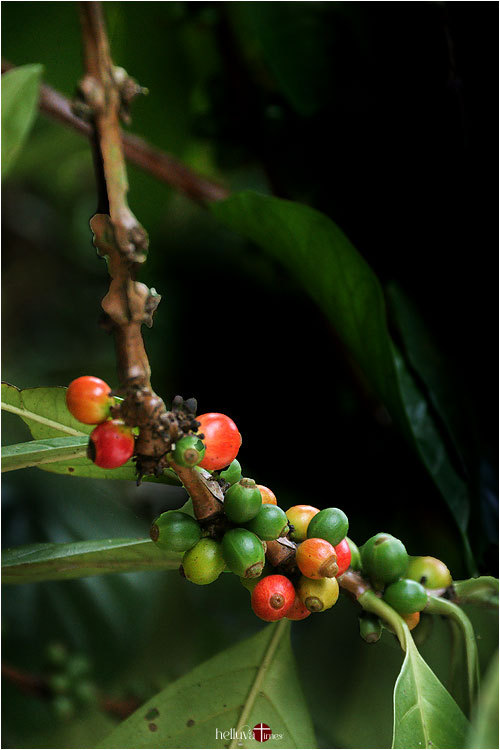
Coffea excelsa (Coffea liberica var. dewevrei) bearing fruits in the botanic gardens. Photo credit: Jonathan Chua.
“Excelsa coffee, a name that evokes whispers of exoticism and whispers of rarity, is a bean shrouded in its own unique allure. While Arabica and Robusta take center stage in the global coffee scene, Excelsa occupies a niche corner, tantalizing adventurous palates with its distinctive character and elusive nature.” – excelsacoffee.org
#photographers on tumblr#Coffea excelsa#Coffea liberica var. dewevrei#flora fauna#flora photography#lumix photography#panasonic lumix dc-s1#Rubiaceae#sigma 18-300mm
11 notes
·
View notes
Note
"What type of coffee do you like? Any favorites I should know of?"
Darck perked up immediately, looking far too happy about this question. Her many rows of sharp fangs receeding to the normal canines as she smiled normally for the first time today. "Well now you're going to make me excited for coffee."

"When it comes to coffee, my favorite kinds of coffee beans are Robusta, Excelsa, and Arabica! Strong, and flavorful. Great for mixing different kinds of mixed coffee's. As for fully brewed type's? Doppio, Café au Lait, Cà phê đá, various kinds of Espresso, Bucharest Brew, other kinds of latte's... I'm not picky, as long as it's strong!"
#Work Invoice :: Asks#vxmpirehunterd#Creeper Gonna Creep :: Darck In Character#Ancient Dhampir Plus One :: vxmpirehunterd#(( this woman is addicted ))#(( her coffee addiction is because of an ada wong many years ago. ))#(( you are going to make her so pleased. ))
3 notes
·
View notes
Text
From Colonial Country to Coffee Powerhouse
The story of Vietnamese coffee begins in the mid-19th century when French colonists introduced coffee plants to the country. The fertile highlands of Vietnam, with their cool climate and rich soil, proved to be a perfect match for coffee cultivation.
Initially, it was planted experimentally on the grounds of Catholic churches in northern provinces like Ninh Binh and Thanh Hoa, and later in central provinces such as Nghe An, Quang Binh, and Quang Tri.
Then, in 1908, the French brought two more coffee species to Vietnam: Robusta and Excelsa.
After years of experimental cultivation throughout the country, it became clear that Arabica coffee plants didn't thrive in Vietnam's climate. Robusta, however, flourished in the central Tay Nguyen Plateau, thanks to the region's favorable climate and soil conditions. Coffee production began to center in provinces within the Tay Nguyen area, particularly Buon Ma Thuot and Lam Dong. While Arabica coffee was initially favoured, Robusta beans soon took the lead due to their resilience and higher yields.
Following the war and a period of economic crisis in Vietnam, the government prioritized coffee production as one of the nation's key industries. By the 1990s, Vietnam had earned its place among the world's leading coffee producers, claiming the top spot in Southeast Asia.
Today, Vietnam still stands tall as a coffee giant, ranking among the world's top producers and exporters. Its high-quality Robusta beans are sought after globally, making a significant contribution to the world's coffee supply.
Souce: izitour.com
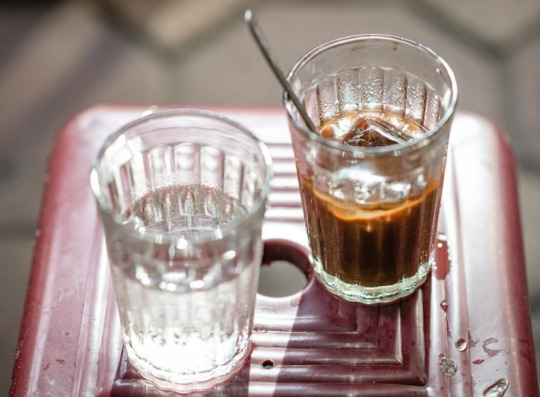
3 notes
·
View notes
Text
Types of Hot Coffee Drinks
Coffee is one of the most popular beverages. The love for coffee is deeply ingrained in many cultures around the world. No other beverage is as revered or respected as coffee.
1. Arabica
Arabica beans are often considered superior in taste and dominate the specialty coffee market. Arabica beans are a single-origin coffee known for their flavors and grow at higher elevations.
An Arabica shrub grows up to 15 feet (5m) tall but is usually pruned to about 6 feet (2m) to make it more commercially viable.
Despite containing less caffeine than Robusta, Arabica tends to have a smooth, mild acidity and notes of fruit. Blends often feature Arabica for a well-balanced and aromatic cup.
Growing Regions: Arabica beans are grown at higher altitudes in regions with cooler temperatures. Key Arabica-producing countries include Ethiopia, Colombia, Brazil, Costa Rica, and Kenya.
Flavor Profile: Arabica beans are renowned for their complex flavors, including fruit notes, floral tones, and mild acidity.
2. Robusta
Robusta coffee beans are resilient, high in caffeine, and grow in low-altitude regions. Robusta is a stouter plant about twice the size of Arabica and grows well in higher humidity.
Robusta’s bold, earthy taste with a hint of bitterness makes it ideal for espresso blends, adding depth and an intense kick to the cup. It is an excellent option for those who prefer intense flavors in their morning cup.
Growing Regions: Robusta beans are typically grown in lower-altitude areas with warmer temperatures. Major Robusta-producing countries include Vietnam, Brazil, Indonesia, and parts of Africa.
Flavor Profile: Robusta beans are known for their bold, earthy taste, higher caffeine content, and a hint of bitterness. They are often used to add depth to espresso blends.
3. Liberica
Liberica coffee beans, originating from West Africa, are known for their unique taste profile and larger size compared to other varieties. These beans thrive in warm climates and are often grown in regions with high humidity.
Growing Regions: Liberica beans flourish in regions with warm climates and ample rainfall. They are predominantly cultivated in countries such as Liberia, Ivory Coast, and the Philippines, where the conditions are favorable for their growth.
Flavor Profile: Liberica beans offer a unique and sometimes fruity taste, distinct from other coffee varieties. They are known for their bold flavor with hints of floral and fruity notes, making them a distinctive choice for coffee enthusiasts seeking something different. Liberica beans can add complexity and richness to coffee blends, contributing to diverse flavor profiles.
4. Excelsa#
Excelsa coffee beans, originating primarily from Southeast Asia, are renowned for their distinctive and complex flavor profile, often characterized by fruity and tart notes. These beans thrive in regions with warm climates and high altitudes, contributing to their unique taste.
Growing Regions: Excelsa beans are predominantly cultivated in countries such as the Philippines and Indonesia, where the climate and altitude provide optimal conditions for their growth.
Flavor Profile: Excelsa beans offer a complex and fruity flavor profile with hints of tartness and a unique aroma. They are prized for their ability to add depth and complexity to coffee blends, making them a favored choice among enthusiasts seeking adventurous flavors.
2 notes
·
View notes
Note
Coffee beans...
Please?
- 🪶
Valerie?
Didn't I just give you some a few days ago?
That good huh? Okay, we've got a few choices this time.
We've got...Arabica, Robusta, Excelsa, and Liberica. I know a guy who knows a guy and once I mentioned getting them for you? A whole lotta doors seemed to have opened up.
So...take your pick little bird.
4 notes
·
View notes
Text
how coffee beans vary around the world
OKAY SO ACTUALLY THIS IS INTERESTING there are four main types of coffee beans but for the sake of time and also i dont want to, we're only going to look at three: arabica, robusta, and excelsa
arabica beans are most commonly grown in ethiopia, guatemala, columbia, and brazil
these are actually the beans that were first grown and created the whole coffee trend worldwide
these specific coffee beans are slightly elongated, and actually have not that much caffeine compared to robusta beans
however, regardless of their lack of caffeine, these beans are often considered to be superior because they are smooth and sweet (and seductive??? maybe.)
robusta beans, compared to arabica beans, are short and stout (like a little teapot)
most commonly grown in vietnam, brazil, indonesia, uganda, and india, these beans are grown in the "bean belt" which is between 25°N and 30°S
these beans have more caffeine than arabica beans, so they are typically stronger and bitter...er
last but certainly not least, we have excelsa beans
these beans are typically grown in vietnam and the phillipines, and they are the most oval-shaped out of the three we have learned about today
excelsa beans are crazily complex, so they are bitter, sweet, AND sour
like pick one and stick to it?? try-hard
across all these countries that grow these coffee beans, they all use them for the same purpose: making coffee
everyone can be united via coffee
be addicted.
0 notes
Text

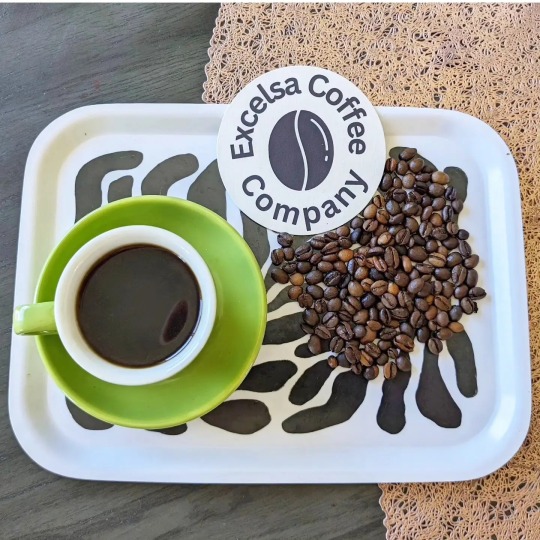
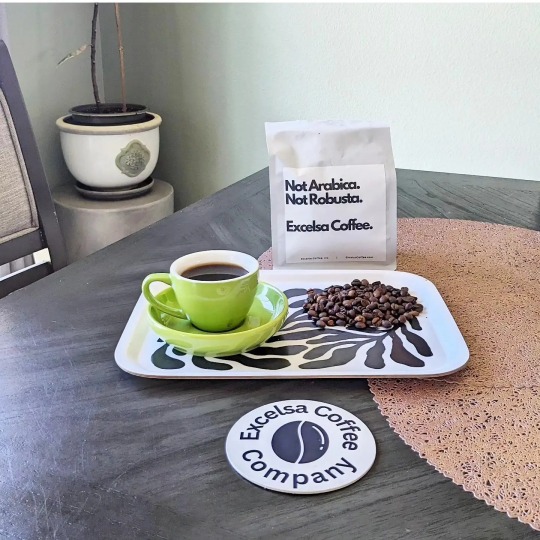

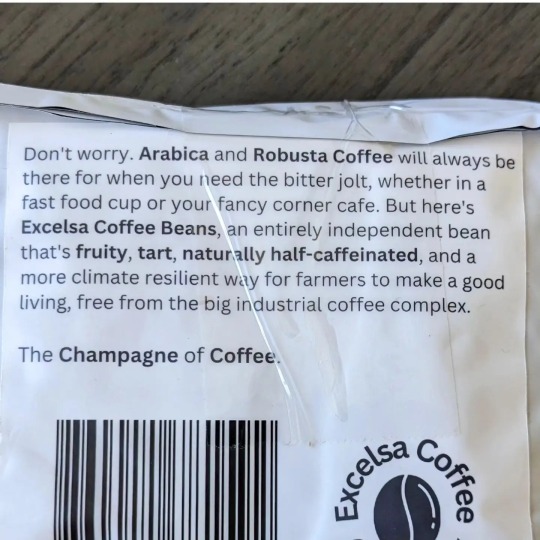
☕ Do you ever get stomach problems from drinking coffee? For years, coffee wrecked my stomach. I thought it was the caffeine… but turns out, it was something worse. Some conventional coffee is sprayed with unregulated pesticides, especially in countries with lax rules. Thankfully @drinkexcelsa is the better alternative because it is naturally pest-resistant, no pesticides, and smooth on my stomach. Now I actually enjoy coffee again. If coffee messes with your gut, it might not be the coffee… just the wrong one. Excelsa coffee is an independent bean that is incredibly resilient (no pesticides needed), bright and fruity (bitter free), and lower caffeinated. They are working to bring this bean to market to provide more options and choices for coffee lovers. @TIME Magazine in March 2025 called excelsa the coffee bean of the future. Try this new coffee for yourself and let me know what you think!
https://excelsacoffee.com/products/excelsa-coffee-100-pure-excelsa-coffee-beans-whole-roasted
1 note
·
View note
Text
Choosing the Right Coffee Beans: A Guide to Finding Your Perfect Brew
Choosing the right coffee beans is essential to crafting a delicious cup of coffee that suits your taste preferences. With so many varieties available, it can be overwhelming for both newcomers and seasoned coffee enthusiasts. However, Choosing the Right Coffee Beans understanding a few key factors can help you find the perfect beans to make your ideal brew.

Firstly, consider the type of coffee bean. There are four main varieties: Arabica, Robusta, Liberica, and Excelsa. Arabica beans are the most popular and are known for their smooth, mild flavor and higher acidity. They are ideal for those who enjoy a refined, aromatic coffee. Robusta beans, on the other hand, have a stronger, more bitter flavor with higher caffeine content. They’re often used in espresso blends for an added punch. Liberica and Excelsa beans are less common but have unique flavors, often fruity or floral, offering a distinct experience for adventurous coffee drinkers.
Next, think about the origin of the beans. Coffee beans are grown in various regions around the world, and their flavors are influenced by the soil, climate, and altitude at which they’re cultivated. Beans from Central and South America, such as those from Colombia or Costa Rica, tend to have bright acidity and fruity flavors. African coffees, like Ethiopian or Kenyan beans, often boast floral notes and complex, fruity profiles. Beans from Asia, such as Sumatra or Java, tend to have earthy, spicy flavors, with a heavier body. Each region offers its own unique flavor characteristics, so it’s worth exploring different origins to discover what suits your palate.
Roast level is another crucial factor in selecting the right beans. Coffee beans are roasted to various levels, ranging from light to dark. Light roasts preserve the natural flavors of the beans, emphasizing their acidity and floral notes. These are perfect for those who enjoy a brighter, more nuanced coffee. Medium roasts strike a balance between acidity and sweetness, offering a smooth, well-rounded cup. Dark roasts, with their bold, smoky flavors, are ideal for those who prefer a rich, intense brew. Experimenting with different roast levels can help you find the perfect strength and flavor for your taste.
When it comes to freshness, it’s best to buy whole beans rather than pre-ground coffee. Grinding your beans just before brewing preserves the oils and aromas, ensuring a fresher, more flavorful cup. Ideally, buy beans in smaller quantities to ensure they stay fresh and are used within a few weeks of roasting. If possible, buy from local roasters who prioritize freshness and quality, or opt for brands that provide roasting dates on their packaging.
Finally, consider your brewing method. Different brewing methods, such as espresso, pour-over, French press, or drip coffee, require different grind sizes and roast profiles. For example, espresso requires a fine grind and typically benefits from darker roasts, while French press coffee requires a coarser grind and pairs well with medium roasts. Understanding the nuances of your brewing equipment will help you choose the beans that will deliver the best results.
In conclusion, choosing the right coffee beans is a personalized journey that involves experimenting with bean varieties, roast levels, and origins. With a little exploration and a willingness to try different options, you’ll be able to find the perfect coffee beans to create your ideal brew.
1 note
·
View note
Text
Discover the Bold Flavors of Liberica Coffee: A Coffee Experience Like No Other
Are you ready to elevate your coffee experience? Whether you're a seasoned enthusiast or simply curious to explore new flavors, Liberica coffee offers a unique journey that captivates the senses. Known for its robust flavors and rich cultural heritage, this distinctive coffee variety stands apart from others like Arabica and Robusta.
Hailing from Southeast Asia, particularly the Philippines, Liberica has deep agricultural roots. It is especially famous in the Philippines where Kape Barako, a variety of Liberica, symbolizes both heritage and identity. If you're a coffee lover with an adventurous palate, Liberica might be the next exciting discovery for you.
What is Liberica Coffee?
Liberica accounts for only a small portion of global coffee production, making it a rare gem in the coffee world. Originating from the lush highlands of Cavite and Batangas in the Philippines, Liberica beans are significantly larger and more teardrop-shaped than their Arabica and Robusta counterparts. These large beans give Liberica its complex, smoky brew, often described as rich and fruity with floral undertones.
The distinctive flavor of Liberica sets it apart from more common coffee varieties. It's celebrated for its full-bodied richness, offering hints of jackfruit, dark chocolate, and cacao nibs in every cup. For more on its fascinating background, check out this insightful article on the origins of Kape Barako and its role in Southeast Asia.
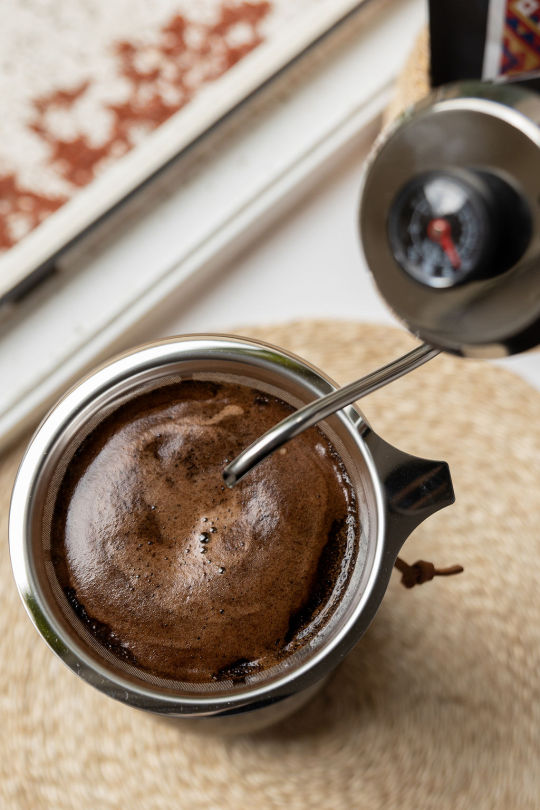
The Rise and Fall of Liberica Coffee
Liberica first rose to prominence in the late 19th century when coffee leaf rust devastated Arabica crops across Southeast Asia. With its resilience and ability to grow in warm, lowland regions, it was considered a potential replacement for Arabica. Despite its initial success, Liberica faced challenges that hindered its global commercialization by the early 20th century. However, recent interest in climate-resistant coffee species has put Liberica back in the spotlight.
As climate change impacts coffee production worldwide, Liberica, especially its Excelsa variant, offers renewed hope. It is more adaptable to warmer climates than Arabica and can withstand harsher conditions, making it an appealing choice for future coffee farming. Learn more about Liberica’s potential in the modern coffee landscape by exploring this comprehensive resource.
What Sets Liberica Apart?
The natural growth process of Liberica enhances its flavor complexity. As the beans ripen, they develop sweet, fruity notes. When brewed, these beans deliver a bold taste with layers of rich flavors like smoky undertones and floral hints. Its versatility makes it ideal for both espresso and filter brewing methods.
For those willing to explore beyond the typical coffee experience, Liberica offers a bold and unique flavor profile. Its fruity sweetness combined with a smoky, almost woody undertone creates an adventure for the palate. This is particularly evident in Kape Barako, the Filipino variant of Liberica, which is known for its strong, bold body. To explore more about the fascinating characteristics of Liberica coffee, check out this detailed guide.
Climate Change and Coffee Farming
Global coffee production faces increasing challenges due to climate change, such as rising temperatures and unpredictable weather patterns. For coffee farmers, the future looks uncertain with many traditional coffee species struggling to adapt. Fortunately, Liberica offers hope. Its resilience to warmer temperatures and ability to thrive in lowland areas make it a promising alternative to Arabica and Robusta.
To combat the impacts of climate change, the coffee industry is exploring new options, including relocating farms to suitable climates, improving agricultural practices, and developing more resilient coffee species like Liberica. Learn more about how Liberica is positioned as a climate-friendly solution for coffee farming in this article.
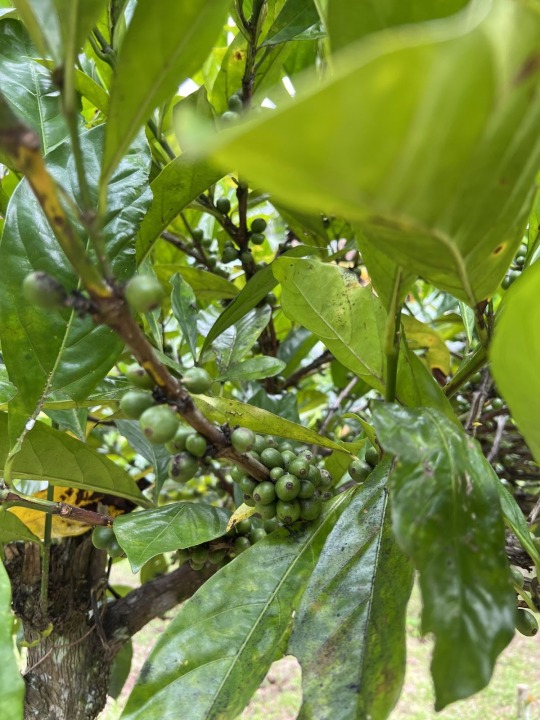
Why Should You Try Liberica Coffee?
For adventurous coffee lovers, Liberica offers a refreshing departure from the usual coffee varieties. Whether you’re a fan of strong, bold brews or prefer a hint of sweetness in your cup, Liberica promises a complex flavor that delights the palate. Each sip offers layers of taste, from its fruity sweetness to its smoky richness, making it an unforgettable experience for those willing to explore.
If you’re ready to dive into this one-of-a-kind coffee journey, Kape de Filipina is your go-to source for premium Barako coffee. We are committed to providing the finest Liberica coffee, sourced directly from the highlands of Cavite, where the beans are grown sustainably by Filipino farmers.
Experience the Bold Flavors of Liberica with Kape de Filipina
At Kape de Filipina, we take pride in offering you the best of Philippine Liberica coffee. Our Barako coffee is medium-dark roasted to perfection, delivering a full-bodied cup with hints of cacao and dark chocolate. Whether you're looking for a rich espresso or a flavorful filter brew, our Barako will exceed your expectations. Plus, when you buy from Kape de Filipina, you're supporting sustainable farming practices and helping to preserve the rich heritage of Liberica coffee in the Philippines.
Ready to make your next brew extraordinary? Explore our range of premium Barako coffee and other Liberica products on our online store. You can also read more about the fascinating history and cultural significance of Liberica in the Philippines on our blog.
Don’t miss out on the chance to experience a coffee that offers both flavor and history in every cup. Shop now and taste the difference with Kape de Filipina!
0 notes
Text
The Ultimate Guide to Kape de Filipina: Experience the Best Coffee from the Philippines
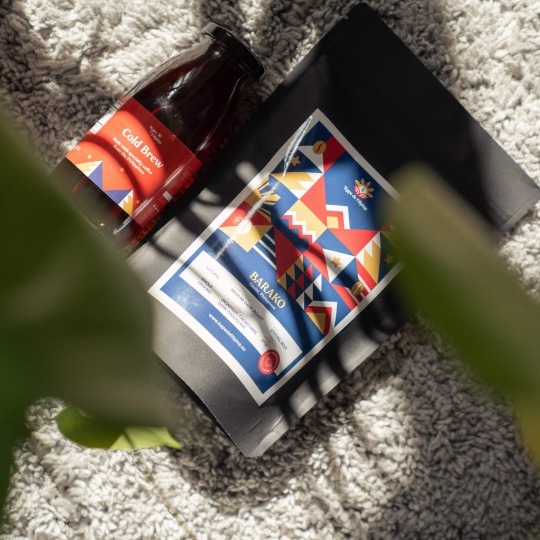
Coffee lovers across Europe are constantly on the hunt for new flavors and unique stories behind every cup. Among the rising stars in the coffee world is the Philippines, an emerging gem that offers a variety of distinct coffees rich in heritage and flavor. Leading this revolution in Germany, Austria, and the Netherlands is Kape de Filipina, a Berlin-based brand dedicated to bringing the finest Philippine coffee to European coffee enthusiasts. By celebrating the heritage and quality of Philippine beans, including the celebrated Barako, the term used by Filipinos to refer to Liberica coffee, Kape de Filipina is redefining how European coffee lovers experience and appreciate coffee from the Philippines.
A Brief History of Philippine Coffee: The Roots Behind Kape de Filipina
The story of coffee in the Philippines began in the 18th century when Spanish colonizers introduced coffee plants to the fertile lands of Batangas. Over time, coffee farming spread to other provinces like Benguet, Cavite, and Bukidnon, where the combination of rich soil, ideal altitude, and tropical climate helped shape the country’s unique coffee profiles. The Philippines soon became one of the world’s leading coffee producers, known for its robust and diverse varieties, including Arabica, Robusta, Excelsa, and Liberica. However, the industry faced setbacks in the 19th century, including pest infestations and economic challenges, which led to a significant decline in production.
Today, the coffee industry in the Philippines is experiencing a renaissance. Thanks to the dedication of local farmers and a growing global appreciation for unique coffee origins, Philippine coffee is gaining recognition for its rich flavors and distinct profiles. This resurgence is fueled by passionate growers who have returned to traditional farming methods while also embracing sustainable practices to ensure quality and environmental stewardship.
Kape de Filipina is at the heart of this coffee revival. Based in Berlin, the brand connects coffee lovers in Germany, Austria, the Netherlands, and the rest of Europe to the rich coffee heritage of the Philippines. By sourcing directly from Filipino farmers and cooperatives, Kape de Filipina not only brings authentic, high-quality coffee to Europe but also supports fair trade and ethical practices. Every cup you enjoy helps empower local farmers, preserve traditional farming methods, and promote sustainable agriculture.
Why Choose Kape de Filipina?
Kape de Filipina isn’t just about coffee; it’s about preserving traditions, supporting local farmers, and celebrating Filipino heritage. By focusing on sustainability and ethical sourcing, the brand stands out in a crowded market, particularly in Germany, Austria, and the Netherlands, where there is growing demand for high-quality, ethically produced coffee. Each bag of Kape de Filipina coffee tells the story of its origin—whether it’s the cool highlands of Benguet, the volcanic soils of Mt. Apo, or the sun-kissed fields of Batangas.
For more insights into Kape de Filipina’s journey and how it’s bringing Filipino pride to Europe, check out this feature on GMA.

Exploring the Unique Flavors of Kape de Filipina
Kape de Filipina offers an array of coffee that showcases the diverse flavors of the Philippines. Here’s a closer look at what sets our offerings apart:
Barako: The Rare Liberica BeanLiberica coffee, known in the Philippines as Barako, is distinct for its bold, full-bodied taste and unique aroma. Grown primarily in Batangas and Cavite, this coffee is characterized by flavors of dark chocolate, cacao nibs, and light notes of tropical fruits like jackfruit. It’s a rare find, making up less than 1% of global coffee production, and is a staple in many Filipino households. Kape de Filipina’s Liberica is perfect for those seeking a strong and exotic brew that stands out from typical Arabica or Robusta.
Arabica from the HighlandsSourced from the lush highlands of Benguet and Bukidnon Kape de Filipina’s Arabica beans are known for their smooth, balanced flavors. These beans have bright pleasant acidity, a rich body, and flavor notes ranging from milk chocolate and nuts to subtle floral hints. The processing methods used in these regions bring out the best characteristics of each bean, making them ideal for espresso, pour-over, or French press brewing.
Specialty Coffee from the Volcanic Soils of Mt. Apo and Mt. MatutumEvery Arabica bean from Kape de Filipina is specialty-grade, carefully chosen to showcase the best of the Philippines’ coffee-growing regions. The beans from the volcanic soils of Mt. Apo and Mt. Matutum stand out for their rich flavors, shaped by nature and skilled farmers. Think deep cocoa, sweet brown sugar, and a touch of ripe fruit. Each sip offers a taste of the lush, volcanic highlands, connecting you to the land where these exceptional beans are grown.
Brewing Tips: How to Enjoy Kape de Filipina Coffee
To truly appreciate Kape de Filipina’s unique flavors, it’s essential to brew it correctly. Here are some tips for making the perfect cup :
Espresso Lovers: Kape de Filipina’s Sayet and Mt. Matutum Arabica beans are ideal for espresso, delivering a rich, intense flavor with a strong aroma that espresso enthusiasts will appreciate.
Pour-Over: For a smooth, balanced acidity and bright flavors, try the Bukidnon Arabica or the Liberica (Barako) beans. These varieties are perfect for pour-over methods, allowing their distinctive notes to shine through.
French Press: For a fuller, richer brew, use the Mt. Apo or Atok Arabica beans in a French press. This method will bring out their deep, chocolatey undertones and robust character.
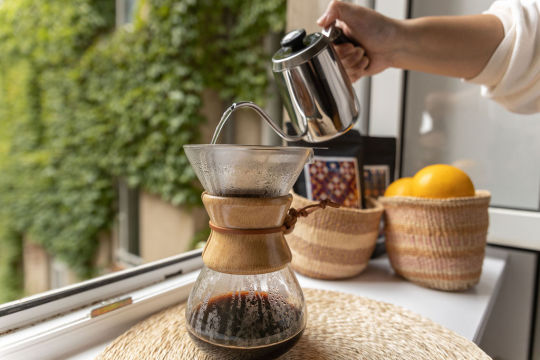
Where to Buy Kape de Filipina
Ready to explore the best of Philippine coffee beans? Kape de Filipina’s range is available online, bringing a taste of the Philippines directly to coffee enthusiasts in Germany, Austria, the Netherlands and across Europe. From the bold and earthy Liberica to the delicate and nuanced Benguet (Atok and Sayet) Arabica, there’s a coffee for every palate.
Discover more about Kape de Filipina’s commitment to quality and sustainable sourcing on the Kintal Creative Studio website, where each coffee tells the story of its origin and the hardworking farmers behind it. You can also check out our inspiring story and impact on the local coffee industry in this video.
Shop now and bring the rich flavors of the Philippines to your cup with Kape de Filipina!
0 notes
Text
The Ultimate Guide to Wholesale Coffee Beans
Coffee is an integral part of daily life for many people around the world. Whether it's a morning ritual, a social activity, or a necessity to get through the day, coffee holds a special place in our routines. For businesses, dealing in wholesale coffee beans offers numerous advantages, such as cost savings, consistent quality, and a reliable supply chain.
The purpose of this guide is to provide a comprehensive overview of how to source, roast, and sell Wholesale Coffee Beans. Whether you are a cafe owner, a retailer, or an aspiring coffee entrepreneur, this guide will give you the knowledge and tools you need to succeed in the coffee business.
Understanding Wholesale Coffee Beans
What are Wholesale Coffee Beans?
Wholesale coffee beans are sold in bulk quantities at a lower price per unit compared to retail beans. These beans are typically purchased by businesses that require large amounts of coffee, such as cafes, restaurants, and retailers.
The primary difference between retail and wholesale beans is the scale of purchase and the price point. Wholesale beans are often sold in larger bags or containers, making them more economical for high-volume buyers.
Benefits of Buying Wholesale
One of the main advantages of buying wholesale coffee beans is the cost savings. Purchasing in bulk allows businesses to get a lower price per pound, which can significantly reduce expenses.
Additionally, buying wholesale ensures a consistent supply of high-quality beans, which is crucial for maintaining the standard of your coffee offerings. This consistency helps build customer trust and loyalty.
Sourcing Wholesale Coffee Beans
Identifying Reliable Suppliers
Choosing the right supplier is crucial for ensuring the quality and reliability of your coffee beans. When evaluating potential suppliers, consider their reputation in the industry, the quality of their beans, and any certifications they may hold.
Certifications such as Fair Trade and Rainforest Alliance indicate that the supplier adheres to ethical and sustainable practices.
Types of Coffee Beans
Coffee beans come in various types, each with distinct flavours and characteristics. The two most popular types are Arabica and Robusta:
Arabica: Known for its smooth, mild flavour and higher acidity, Arabica beans are often considered superior in quality.
Robusta: With a stronger, more bitter taste and higher caffeine content, Robusta beans are generally less expensive and used in blends.
Other varieties to consider include Liberica and Excelsa, which offer unique flavour profiles and can add diversity to your coffee selection.
Evaluating Bean Quality
Several factors affect the quality of coffee beans, including their origin, the climate in which they are grown, and the processing methods used.
When assessing sample batches, look for uniformity in size and colour, a pleasant aroma, and a lack of defects. Tasting the coffee can also provide valuable insights into its flavour, body, and acidity.
Ethical Sourcing
Ethical sourcing is becoming increasingly important to consumers who care about the social and environmental impact of their purchases.
By choosing suppliers with certifications such as Fair Trade and Rainforest Alliance, you can ensure that the farmers and workers who produce your coffee are treated fairly and that sustainable practices are used in the production process. These certifications also appeal to customers who prioritise ethical consumption.
Roasting Coffee Beans
Basics of Coffee Roasting
The roasting process transforms green coffee beans into the aromatic, flavorful beans that we brew. Roasting involves applying heat to the beans, causing them to undergo complex chemical changes.
This process is critical in developing the flavor profile of the coffee, including its aroma, taste, and body.
Types of Roasts
Roasting levels can significantly affect the flavour and characteristics of the coffee. The main types of roasts are:
Light Roast: Light brown in color, with a mild flavor and pronounced acidity. Often preferred for its ability to highlight the bean's origin flavors.
Medium Roast: Medium brown, with a balanced flavor, aroma, and acidity. A popular choice for its versatility.
Dark Roast: Dark brown, with a bold, robust flavour and lower acidity. Preferred for its strong, smoky taste.
Equipment Needed
Commercial roasting requires specialised equipment to achieve consistent results. Key pieces of equipment include:
Roaster: machines designed to roast beans evenly. Options range from small-batch roasters to large industrial machines.
Cooling Tray: Used to cool the beans quickly after roasting to halt the roasting process and preserve flavour.
Grinder: essential for testing roasted beans and ensuring quality control.
Techniques and Tips
Consistency is key when roasting coffee beans. Here are some best practices:
Maintain consistent temperature and airflow throughout the roasting process.
Keep detailed records of each roast to replicate results and make adjustments as needed.
Regularly clean and maintain equipment to ensure optimal performance.
Selling Your Wholesale Coffee Beans
Identifying Your Market
Understanding your target market is essential for successful sales. Potential customers for wholesale coffee beans include cafes, restaurants, and retailers. Each of these segments has unique needs and preferences, so tailor your offerings accordingly.
Packaging and Branding
Attractive packaging and strong branding are critical for standing out in a competitive market. Invest in high-quality packaging that keeps the beans fresh and showcases your brand's identity. Consider sustainable packaging options to appeal to environmentally conscious consumers.
Pricing Strategies
Pricing your coffee beans competitively while maintaining profitability is a delicate balance. Consider factors such as production costs, market demand, and competitor pricing. Offering discounts for bulk purchases or long-term contracts can attract more customers.
Marketing Your Product
Effective marketing strategies can significantly boost your sales. Establish a strong online presence through a professional website and active social media accounts.
Participate in trade shows and industry events to network and showcase your products. Offering samples and engaging in community events can also help build brand recognition and loyalty.
Conclusion
Starting or enhancing a wholesale coffee business requires careful planning and execution. From sourcing high-quality wholesale Coffee Beans and ethical suppliers to mastering the roasting process and effectively marketing your products, each step is crucial to success.
By following the guidance provided in this comprehensive guide, you can establish a strong presence in the coffee industry and delight your customers with exceptional coffee.
0 notes
Text
How to Become a Coffee Connoisseur
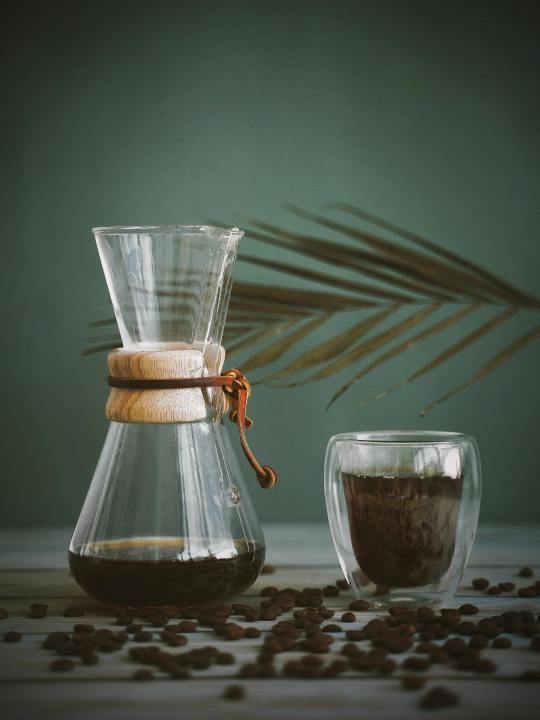
Becoming a coffee connoisseur requires time, commitment, and self-drive for the art. Also known as coffee snobs, a coffee connoisseur is committed to searching for the latest coffee trends and products. But what do you need to join this league of coffee experts?
First, you need in-depth knowledge and a passion for coffee and its various aspects. This includes learning the drink’s history, culture, and production. Additionally, you must understand the specialty coffee drinks, the flavor profiles, different roasts, brewing methods, and the types of beans. For example, the coffee beans to know more about include Arabica, Robusta, Liberica, and Excelsa.
Explore different online resources, cafes, and reputable coffee shops, and attend coffee events, competitions, and workshops because this is where you connect with other coffee enthusiasts and learn from them. You may also learn about the different roasting techniques, such as the light roast, medium roast, medium dark roast, and dark roast.
Doing this can help you familiarize yourself with the different coffee brewing equipment as you develop a unique taste to sample and distinguish various nuances of coffee flavors. Acquainting yourself with coffee brewing equipment goes hand in hand with knowing the different brewing methods, which include Pour Over Coffee, Siphon, and Espresso.
0 notes
Text
Philippines Coffee Market Growth, Demand and Forecast Research Report to 2023
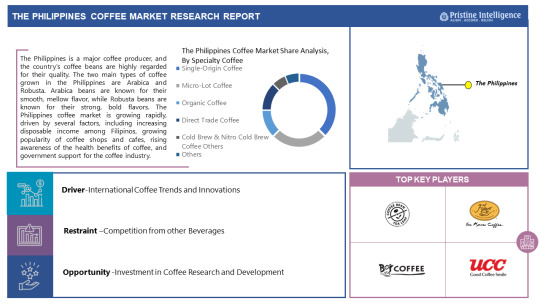
Philippines Coffee Market Overview and Insights:
According to Pristine Intelligence, The Philippines’ Coffee Market is Expected to Grow at a Significant Growth Rate, and the Forecast Period is 2023-2030, Considering the Base Year as 2022.
The Philippines has a long history of coffee cultivation and production, dating back to the 18th century when coffee was introduced by Spanish colonizers. The Philippines has regions with favorable conditions for coffee cultivation, including high elevations, volcanic soil, and a tropical climate. Major coffee-growing regions include Batangas, Benguet, Cavite, and Sultan Kudarat. The Philippines produces both Arabica and Robusta coffee varieties. Arabica is grown in higher elevations, while Robusta is more common in lower elevations. Some popular Arabica varieties include Typica, Bourbon, and Catimor, while Robusta varieties include Robusta, Excelsa, and Liberica (Barako).
The Global Philippines Coffee Market study contains information on the global industry, as well as user data and numbers. The Global Market is examined in depth in this research report, including raw material suppliers, industry chain structures, and manufacturing. The Philippines Coffee Sales market investigates the market's most important segments. This insightful analysis includes historical data as well as a predicted timeframe. This report examines the whole value chain, as well as downstream and upstream fundamentals. This Market study examines the Philippines Coffee Industry's technical data, production plants, and raw material suppliers, as well as which product has the largest penetration, profit margins, and R&D status.
Who are the key players operating in the industry?
Starbucks Philippines (USA), The Coffee Bean & Tea Leaf (USA), Figaro Coffee Company (Philippines), Bo's Coffee (Philippines), UCC (Ueshima Coffee Company) (Japan), Dunkin' Donuts Philippines (USA), Seattle's Best Coffee (USA), McCafe (McDonald's Philippines) (USA), Tim Hortons (Canada), J.CO Donuts & Coffee (Indonesia), Coffee Project (Philippines), The Shangri-La Coffee Garden (Philippines), Gloria Jean's Coffees (Australia), Toby's Estate Coffee (Australia), Coffee Dream (Philippines), The French Baker (Philippines), Bo's Coffee Bigtrain (Philippines), 7-Eleven Philippines (USA), Rustan Coffee Corporation (CBTL) (Philippines), Coffee Alley (Thailand) and Other Major Players
Philippines Coffee Market research is an ongoing process. Regularly monitor and evaluate market dynamics to stay informed and adapt your strategies accordingly. As market research and consulting firm we offer market research report which is focusing on major parameters including Target Market Identification, Customer Needs and Preferences, Thorough Competitor Analysis, Market Size & Market Analysis, and other major factors. At the end we do provide meaningful insights and actionable recommendations that inform decision-making and strategy development.
Get Sample PDF of Philippines Coffee Market with Complete TOC, Tables & Figures @
What is included in Philippines Coffee market segmentation?
The report has segmented the market into the following categories:
By Forms
Whole Coffee Beans
Ground Coffee
Instant Coffee
Coffee Pods & Capsules
Espresso
Others
By Source
Arabica
Robusta
Why Choose Pristine Intelligence Report?
A smart dashboard that provides updated details on industry trends.
Data input from various network entities such as suppliers, suppliers, service providers etc.
Strict quality inspection standards: data collection, triangulation and verification.
We provide service 24 hours a day, 365 days a year.
Competitive Analysis of the market in the report identifies various key manufacturers of the market. We do company profiling for major key players. The research report includes Competitive Positioning, Investment Analysis, BCG Matrix, Heat Map Analysis, and Mergers & Acquisitions. It helps the reader understand the strategies and collaborations that players are targeting to combat competition in the market. The comprehensive report offers a significant microscopic look at the market. The reader can identify the footprints of the manufacturers by knowing about the product portfolio, the global price of manufacturers, and production by producers during the forecast period.
Discount on the Research Report @
Research Methodology:
Pristine Intelligence inculcated modern methodologies to obtain, summarize and analyze authentic data to produce a highly relevant report which helps to make sound decision making. Primarily, we are working based on research methodologies, including primary and secondary research. We gather data for the secondary research from an assortment of sources, including published official articles, annual reports, official corporate websites, private company journals, and paid databases such as Statista, Factiva, Euromonitor, D&B, and IMR's Data Repository, among others. In the primary research, we contact the key companies in the market, gather the necessary data, and have it analyzed by experts in the industry.
Highlights from the report:
Market Study: It includes key market segments, key manufacturers covered, product range offered in the years considered, Global Philippines Coffee Market, and research objectives. It also covers segmentation study provided in the report based on product type and application.
Market Executive Summary: This section highlights key studies, market growth rates, competitive landscape, market drivers, trends, and issues in addition to macro indicators.
Market Production by Region: The report provides data related to imports and exports, revenue, production and key players of all the studied regional markets are covered in this section.
Philippines Coffee Market Profiles of Top Key Competitors: Analysis of each profiled Roll Hardness Tester market player is detailed in this section. This segment also provides SWOT analysis of individual players, products, production, value, capacity, and other important factors.
If you require any specific information that is not covered currently within the scope of the report, we will provide the same as a part of the customization.
About Us:
We are technocratic market research and consulting company that provides comprehensive and data-driven market insights. We hold the expertise in demand analysis and estimation of multidomain industries with encyclopedic competitive and landscape analysis. Also, our in-depth macro-economic analysis gives a bird's eye view of a market to our esteemed client.
Our team at Pristine Intelligence focuses on result-oriented methodologies which are based on historic and present data to produce authentic foretelling about the industry. Pristine Intelligence's extensive studies help our clients to make righteous decisions that make a positive impact on their business. Our customer-oriented business model firmly follows satisfactory service through which our brand name is recognized in the market.
Contact Us:
Office No 101, Saudamini Commercial Complex,
Right Bhusari Colony, Kothrud,
Pune, Maharashtra,
India - 411038
(+1) 773 382 1049
+91 - 81800 - 96367
Email: [email protected]
0 notes
Text
Top 5 Coffee Beans In The World

top 5 coffee Beans in the world
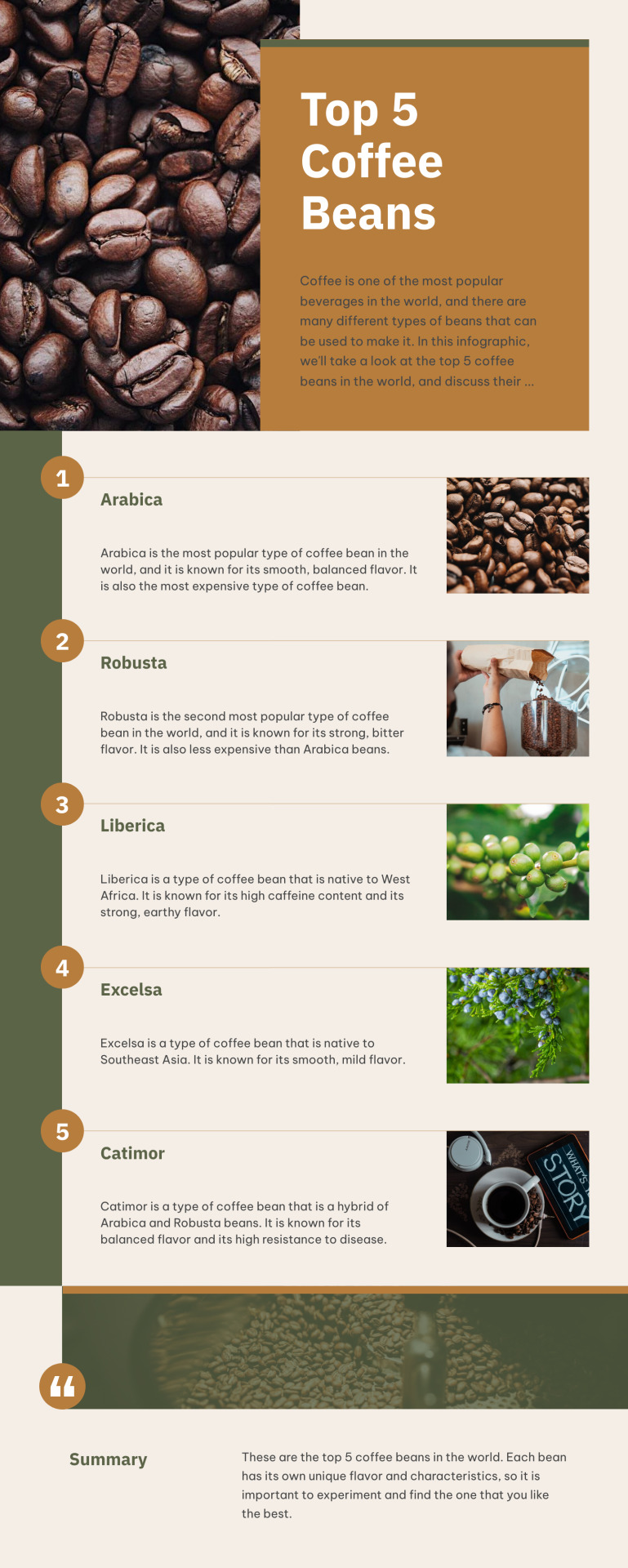
If you like to know more, keep reading: Beyond the familiar duo of Arabica and Robusta, a world of unique coffee adventures awaits. Imagine Liberica, the rare giant boasting smoky-floral notes, or Excelsa, the high-altitude gem with hints of stone fruit. Intrigued? Prepare to delve into lesser-known varieties like the chocolaty Catimor, prized for its balanced sweetness and notes of citrus and spice, and the Blue Mountain from Jamaica with its rich, chocolaty depth. Each origin and bean unveils a distinct journey for your coffee-loving palate. Liberica Often overshadowed by its ubiquitous cousins Arabica and Robusta, Liberica coffee beans offer a truly unique sensory experience. These irregularly shaped giants, nearly twice the size of Arabica beans, boast a captivating aroma redolent of sweet florals and exotic fruits, reminiscent of jackfruit. On the palate, Liberica delivers a bold and complex punch, characterized by smoky, woody notes interwoven with subtle nuttiness. Sadly, this rare gem faces extinction, clinging to survival in Southeast Asia. However, for adventurous coffee connoisseurs seeking to support biodiversity and savor an unparalleled flavor journey, Liberica presents an opportunity not to be missed.

Liberica Beans While Liberica coffee originated in Liberia, currently the Philippines holds the title of the largest producer of Liberica beans. It's known locally as "kapeng barako" and holds cultural significance, particularly in Batangas and Cavite provinces. However, it's primarily consumed domestically.Malaysia ranks second in Liberica production, mainly concentrated in the west coast's "Coffee Belt". Interestingly, their production outpaces Arabica within the country.Although Brazil exports the most Liberica beans, its total production compared to the Philippines and Malaysia remains lower. Additionally, Liberica makes up a small portion of Brazil's overall coffee output. Excelsa What's particularly intriguing about Excelsa is its naturally lower caffeine content, hovering around 40% of what you'd find in a regular cup of Arabica coffee, even less than a Robusta. This makes it a perfect choice for those seeking a smoother, less jittery coffee experience. Plus, its unique flavor profile shines through whether roasted light or dark, offering a versatile pick for adventurous coffee lovers. So, if you're ready to ditch the ordinary and explore the hidden gems of the coffee world, Excelsa awaits!
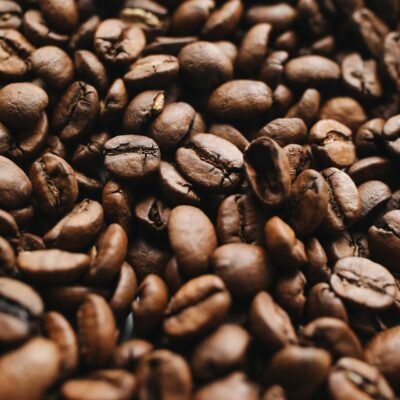
Excelsa Beans Based on available information, the Philippines and Vietnam are the two top producers of Excelsa coffee beans in the world. Excelsa gained popularity among Filipino farmers due to its pest resistance and unique flavor profile. Nevertheless, Excelsa remains a niche coffee globally.Step aside, Arabica, Robusta and Liberica! Excelsa coffee beans offer a flavor adventure unlike any other. These small, round gems, often hailing from Southeast Asia, pack a punch in terms of the taste. Forget your typical coffee profile - Excelsa leans into the unique, boasting vibrant acidity, fruity notes reminiscent of blackcurrant and grapefruit, and even a touch of earthiness that reflects its natural origins. Some describe its aroma as subtly woody, hinting at its complex depth. Catimor Born from a blend of tradition and resilience, Catimor coffee beans are a unique player in the global coffee scene. This hybrid, marrying the disease resistance of Robusta with the aromatic complexity of Arabica, thrives in diverse environments like Vietnam, India, and Indonesia. Known for its compact stature and bountiful yields, Catimor has secured its place as a vital crop for many farmers.

Catimor Beans Flavor-wise, Catimor offers a captivating journey. Expect a balanced and sweet cup, often marked by citrusy notes like orange and lime, mingling with hints of spice like cinnamon and nutmeg. Depending on the origin and roast, chocolatey undertones or a touch of floral aroma might emerge. Whether enjoyed as a bright filter coffee or a rich espresso, Catimor promises a satisfying and distinct experience. So, next time you seek a coffee beyond the ordinary, consider Catimor - a testament to both innovation and the diverse landscape of coffee flavors.With limited data available, Vietnam is widely considered the country that produces the most Catimor coffee beans. Catimor was introduced to Vietnam in the 1980s and quickly gained popularity due to its resistance to leaf rust, a major threat to coffee trees. Due to its high yield and disease resistance, Catimor plays a crucial role in the Vietnamese coffee industry, influencing the overall quality and economic impact of the sector. Countries like India and Indonesia are also cultivating Catimor, contributing to its global availability. Conclusion While Arabica reigns supreme with its smooth complexity and Robusta offers its bold kick, a world of exciting flavors awaits. Liberica, the giant bean, enthralls with smoky-floral notes, while Excelsa, the high-altitude gem, tantalizes with bursts of blackcurrant and grapefruit. Don't miss Catimor, the resilient hybrid, offering a balanced dance of citrus and spice.Each bean, a distinct journey for your palate, whispers tales of unique origins and passionate cultivation. Venture beyond the familiar and embark on a global coffee odyssey. So, ditch the routine, embrace the diversity, and savor the world's top coffee beans – one delicious cup at a time. Email Twitter Pinterest Facebook LinkedIn Reddit Keep In Touch If You Like My Articles. As much as I like to share my knowledge and skills with you, I love to hear from you. If you have any suggestions or comments, please click here. Also don't forget to subscribe to our quarterly newsletters if you like my blogs and like to keep in touch.Of course, read more blog posts I post now and then, such as "Making Coffee Without a Coffee Maker". Read the full article
0 notes
Text
🌟 Exploring Coffee Flavors: A Journey Through Bean Diversity ☕
Hey there, fellow coffee aficionados! Today, we're embarking on a flavor-filled adventure through the mesmerizing world of coffee. Join us as we unravel the captivating stories behind different coffee bean types and their delightful flavors, from the delicate nuances of Arabica to the bold character of Robusta. There's a coffee variety for every palate, and we're about to dive deep into this aromatic realm.

The Coffee Spectrum: Coffee is not just a beverage; it's a spectrum of experiences waiting to be explored. Each cup has its own unique tale to tell, whether it's the vibrant acidity of a Kenyan AA or the comforting sweetness of a Colombian Supremo.
Arabica vs. Robusta Beans: Let's start by comparing the heavyweight contenders, Arabica and Robusta. Arabica, known for its elegance, often presents floral and fruity notes, while Robusta boasts robust flavors with hints of earthiness and nuttiness. The choice between them sets the tone for your coffee adventure.
Other Coffee Bean Varieties: But wait, there's more! We'll also introduce you to lesser-known coffee bean types like Liberica and Excelsa, each offering a unique twist to your daily brew.
Specialty Coffee Sensation: In recent years, the coffee world has witnessed the rise of specialty coffee. Dive into this movement, which emphasizes single-origin beans and micro-lot coffees, resulting in a rich tapestry of flavors.
Mastering the Art of Coffee Tasting: Elevate your coffee experience with our expert tips on tasting coffee notes. It's like taking a journey through your senses, uncovering the hidden treasures in every cup.
Coffee Pairings: Coffee isn't just a solitary pleasure; it thrives in the company of complementary flavors. Experiment with coffee pairings to discover exciting new tastes.
So, fellow coffee lovers, which coffee bean type and flavor has left you intrigued? Share your coffee journey with us in the comments below, and don't forget to check out our video for an in-depth exploration of coffee flavors. Subscribe, like, and share to spread the love for this enchanting brew! ☕🌍
#CoffeeFlavors#ArabicaVsRobusta#SpecialtyBeans#TastingTips#BeanDiversity#CoffeePairings#BrewingMethods#AromaExperiences#UniqueVarieties#FlavorProfiles#CoffeeExploration#RareBeans#CoffeeNotes#TasteDifferences#CoffeeOrigins#BeanChoices#CoffeeLoversUnite
1 note
·
View note